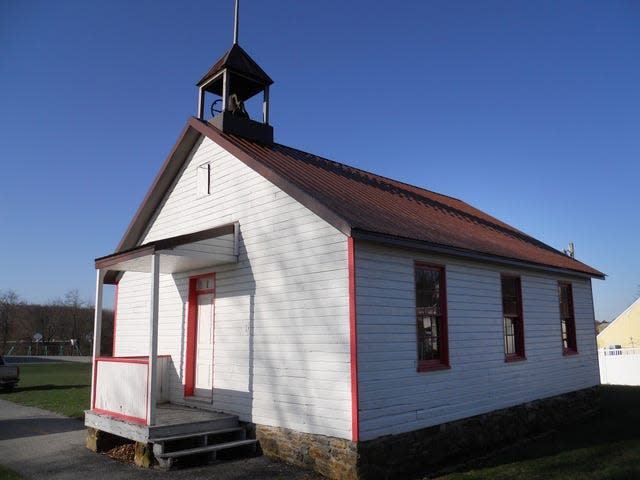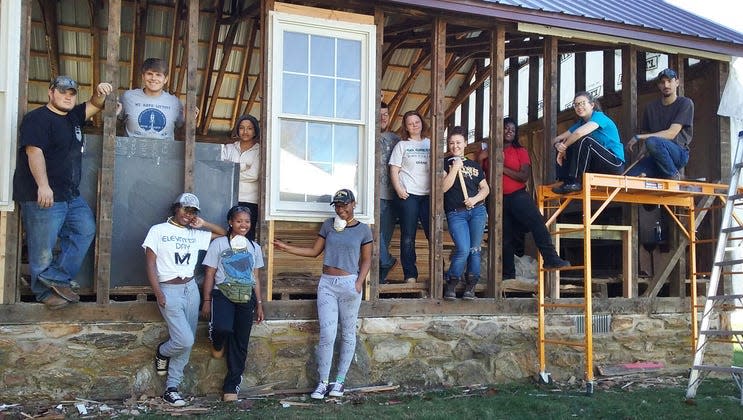One-room school teaches lessons of York County life 100 years ago
Editor’s note: This story was adapted from a column by James McClure on Oct. 30, 2017. An expanded version is posted on WitnessingYork.com, a digital site operated by McClure and historian Jamie Kinsley.
It was a sunny October Sunday afternoon in Red Lion five years ago, and a group of students sat at desks eager to learn about one-room schools.
They soon took in the fact that York County was a leader in the state in one-room schools before World War II, with more than 350 of those small buildings dotting the countryside. York County covers a 900-square-mile area with among the highest populations in the state, and these public one-room schools provided the educational answer from the mid-1830s to after World War II.

The one-room schools started giving way to larger schools with classrooms for specific grades before the war. After those in uniform returned and the population started increasing, the construction of regional buildings escalated and the old schools closed in bunches. The number of school districts decreased, too, from 32 to 15.
The students learned what their forebears ate for lunch: leftovers from their family meal the night before. Produce grown on the farm. Fruit picked, legally or not, from orchards on the way to school. And yes, peanut butter and jelly sandwiches.
And they absorbed the condition of some of those one-room schools, as characterized years ago by county school Superintendent William H. Kain: “The school house of 50 years ago was a low, unplastered, unceiled, besmoked, old log shop, the clinking of which had fallen out enough to enable the scholars to crawl in and out.”
At one-room school reunions, those who experienced such educations – with all eight grades plugged into one room – like to reflect about ubiquitous outhouses. That usually devolves into the use of Sears and Roebuck catalogs in those privies and what students liked to do with those small buildings. That is, turn them over, when, one would hope, no one was in there.
Now in 2022, one-rooms schools remain a topic of interest in York County.
Historian Jamie Kinsley and archivist Dominish Marie Miller will talk about York County’s one-room schools in the Season 2-opening episode of their online series, “Hometown History.” The discussion is set for 7 p.m. Jan. 20 before a live audience at the Blue Sky Tavern in Newberry Township. It will also be livestreamed on the Retro York and Preserving the History of Newberrytown Facebook groups.

One-room schools ran course
The students at the desks this Sunday in 2017 were following in the footsteps of one-room schoolers. And sitting in their seats.
These dozen home school students, who likely never experienced the walk to an outhouse on a freezing night, were experiencing a one-room school firsthand. They were seated in Neff’s School, a then-recently restored, relocated building in the Red Lion Area School District.
The well-schooled students were there as part of an enrichment program sponsored by a public/private partnership coordinated by community mover-and-shaker Ellie Shoemaker.
With all the learning that day in Red Lion, the schoolhouse itself provided instruction – of an unexpected kind.
The talks presented an opportunity to blend traditional and new teaching tools in a rustic school.
Roger Wilson, a retired teacher, used exhibits to make his points about life in those small schools.
For example, with special scissors, he cut a tablet from a sheet of slate to make a small slate tablet.
But how would the schoolhouse cooperate with a colorful PowerPoint presentation projected on the old black board?
This school, though renovated, did not have electricity. There never really was a reason to hook it up.

County education scene changes
And therein surfaced a problem with one-room schools. As the 20th century plodded on, how could eight grades of students with one teacher and no electricity keep up with the demands of an increasingly technological world?
Many students aged out of these old schools after eighth grade, and with the closest high school miles away, they went to work on the family farm or in nearby factories. In York County, this contributed to a high school graduation rate of less than 50% in 1970.
Coincidentally, York College started offering four-year classes about that time, the first for any college within county borders.
When the low high school graduation rate was added to a lack of opportunity for a nearby four-year collegiate education, the types of new thinking, fresh ideas and vocational tools an education offers went lacking in York County communities. So in 1970, the four-year higher-education comparison between York and Lancaster tallied: York – York College; Lancaster – Elizabethtown, Millersville, Franklin & Marshall/Lancaster Theological Seminary.
Then in the 1950s, newer consolidated elementary and secondary schools offered labs to learn science and kitchens to practice home economics. Gyms beckoned for sports and shops for woodworking. And these consolidated schools included libraries.
Indeed, York County did not host a public library in 1935. In fact, York turned down a Carnegie Library in 1900, when many other communities boasted of them.
These regional schools caused disruption that cut different ways in communities.
This consolidation broke up the tight, often supportive community surrounding the one-room schools, and students no longer attended schools near their homes. Gone were the days that a classroom of students drank from the same ladle. Long bus rides detracted from farm work and family life.
But that disruption had a positive impact. It meant the formation of larger, less-insular communities surrounding these regional schools and the introduction of students to fellow pupils and teachers with different experiences and backgrounds.

Schoolhouse trumped tech
Back at Neff’s School, the Felton Fire Company attempted to fill the electricity gap with a gasoline generator to power the laptops and projector. The projected images against the old blackboard presented a brief, intriguing moment to witness old and the new instructional tools: chalk versus a digitally produced image.
As it turned out, Neff’s School and all its educational traditions won the day.
For many reasons or no reason, the gasping, burping gas-powered generator and extension cords failed to consistently power the laptops and projectors.
Earlier, Wilson had shown the home-schoolers that when one-room students had finished their ciphering, they quietly held up their tablets with the answers for the teacher to see.
At least one student presenter helped adapt this technique by walking down the schoolhouse’s center aisle with laptop in hand showing the PowerPoint slides to fellow students.
“Perhaps the dear little school house jinxed modern technology today,” Shoemaker wrote in an email later that day, “to remind us that we can communicate without 21st Century whistles and gongs.”
Jim McClure is the retired editor of the York Daily Record and has authored or co-authored eight books on York County history. Reach him at jimmcclure21@outlook.com.
This article originally appeared on York Daily Record: One-room school teaches lessons of York County life 100 years ago

